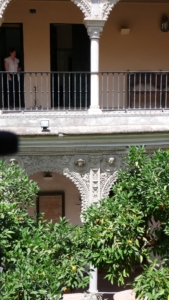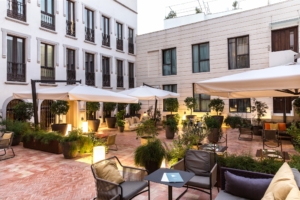THE BEST PALACES IN SEVILLE
One of the best plans to enjoy Seville in a different way its discovering its beautiful palaces. In this post we will try to highlight the ten most spectacular palaces in the city:
- Real Alcázar
The Real Alcázar is one of the most important monuments in Seville and one of the oldest palaces in use in the world, therefore it´s a must-visit when you come to Seville. Declared a World Heritage Site by UNESCO in 1987 receives more than 1 million visits per year.
It is not just only a place with great historical relevance, but it is also one of the most beautiful and curious architectural ensembles in the country, mixing styles of Muslim, Gothic, Renaissance, Baroque and Romantic art.
In the year 913 Abderramán III ordered the construction of a new center of government on top of an old Visigothic settlement that had previously been Roman. This “multicultural” detail of its construction seems a foretaste of the many historical swings that would shape its current appearance.
In 1248, with the conquest of Seville by Fernando III, the Real Alcázar became a Royal Palace (a status that still conserves today) and subsequently he lived through numerous reforms initiated by his son Alfonso X, who ordered the construction of the Gothic Palace. In 1364, Pedro I will commission the Mudéjar Palace, one of the most spectacular areas of the complex. The Renaissance touches of the Real Alcázar come from the reforms made during the reign of the Catholic Monarchs.
As a curiosity we can tell you that some of the venues inside the Real Alcázar have been used as a stage for the popular TV series Game of Thrones.





2. Casa Pilatos
Casa Pilatos is the palace of the Medinaceli dukes. This explains why the Spanish Mudejar building presents a clear influence of the Italian Renaissance. This rich combination makes this palace an essential visit for those who love architecture.
The construction of the palace began in 1483, by initiative and desire of Pedro Enríquez de Quiñones (IV Adelantado Mayor de Andalucía) and his second wife Catalina de Ribera, founders of the Casa de Alcalá. After the death of their parents their sons were the ones who were responsible for completing the decoration of the palace.
The name Casa de Pilatos comes from a Via Crucis that began to be celebrated in Seville in the 16th century. This Via Crucis begins at the door of the palace as the first station, ending in the temple of the Cruz del Campo (neighborhood of Nervión), which would be the germ of Holy Week in Seville.

3. Casa Palacio de la Condesa de Lebrija
Located at Cuna street, parallel to the famous Sierpes street, the Palace of the Countess of Lebrija is a magnificent Palace and Museum. Its origin dates back to the 16th century and is considered the “best paved house-palace in Europe”.
In 1901 it was acquired by the Countess of Lebrija to house its valuable collection of antiquities, until that date it had belonged to different noble families of the city. The family of the Countess lived in the house until 1990, when it became a house museum.
If you decide to visit this house museum you can enjoy an excellent set of Roman mosaics, as well its rooms treasure a multitude of archaeological remains of incalculable historical and artistic value: vases, amphoras, columns, vessels and sculptures. In addition to the archaeological remains you can find elements of the Arab and Roman times, a collection of well curbs, amphoras, columns and sculptures, Greco-Roman busts and mythological representations, along with other Chinese and Persian style.
Among the paintings you can find pieces by Van Dyck, by Bruegel the Elder and paintings by the School of Murillo.

4. Casa de las Dueñas
The Palace of Las Dueñas is a private residence owned by the Casa de Alba that arouses great interest for its historical, architectural and artistic value and for having been the residence of the charismatic Cayetana de Alba.
This spectacular palace was built between the 15th and 16th centuries on top of the remains from the monastery of Santa María de las Dueñas, hence its name. Since its construction it has always belonged to noble families of Seville until in 1612 that it passed into the hands of the Casa de Alba thanks to the marriage between Antonia Enríquez de Ribera and Fernando Álvarez de Toledo, who would be the VI Duke of Alba.


5. San Telmo Palace
The Palace of San Telmo is currently where the Presidency of the Andalusian Government is settled. Located on the Avenida de Roma, it was conceived to become the home to the headquarters of the college-seminar of the University of Merchants.
Its main façade located on Palos de la Frontera street dates from 1754 and is one of the most famous of Baroque-Churrigueresque architecture.
Its lateral facade has sculptures of illustrious Sevillian characters (born and adopted) executed in 1895 by Antonio Susillo, we can see Diego Velázquez, Miguel Mañara, Lope de Rueda, Diego Ortiz de Zúñiga, Fernando de Herrera, Luis Daoíz, Benito Arias Montano, Bartolomé Esteban Murillo, Fernando Afán de Ribera, Bartolomé de las Casa, Rodrigo Ponce de León, Cádiz and Juan Martínez Montañés.

6. Casa de los Pinelo
The palatial house of the Pinelo is the home of the Royal Academies of Fine Arts of Santa Isabel de Hungría and Sevillana de Buenas Letras. The goal of these corporations is the dissemination of the Fine Arts throughout promotional activities, studies, conservation and restoration of works of art and materials that are part of the legacy.
The canon of the Seville Cathedral, Don Diego Pinelo, commissioned its construction during the first third of the 16th century, becoming one of the first and most important noble houses in Seville. Until 1524 it belonged to the Pinelo family who decided to donate it to the Cathedral of Seville.
Since then it has served as the residence of the Canons of the Cathedral, until the confiscations of the nineteenth century. When passing to private hands the house had several uses. In 1966 it becomed the property of the City Council of Seville.

7. Palacio de los Marqueses de la Algaba
Commissioned by the Lord of the Algaba in 1474, the Palace of the Marquises of the Algaba is located on Feria Street, behind “Mercado de Abastos” (food market). It is considered one of the best examples of civil Mudejar art.
Currently, it is a cultural reference in the Casco Antiguo district of Seville, as it is the
headquarters of the Area of Education, Citizen Participation and Municipal Buildings and houses an important museographic collection as well as offering magnificent facilities to Seville’s neighbors.
 8. Casa de la Provincia
8. Casa de la Provincia
Located in the Plaza del Triunfo in Seville, in the heart of its monumental area, between the Cathedral and the Reales Alcázares, and opposite to the Archivo de Indias is the House of the Province.
For many years it has been the seat of the Sevillian Government until 1999 that it was established as a privileged place for the promotion of the city of Seville.

9. Casa Salinas
Located in the heart of Seville’s Old Town, Casa Salinas is a 16th-century palace house.
Since the beginning of the 20th century the house was owned by the Salinas family, therefore its name. This family has been responsible for restoring it thoroughly to resemble it to its original appearance.
Actually, it displays its primitive structures of the 16th century with elements typical of the period of its construction, harmonized aesthetically as reflected in its warm and comfortable interiors.

10. Palacio de Villapanés
The place was built in the 18th century by de Marqués of Torreblanca del Aljarafe. Originally the Place only included the main house, its rooftops and beautiful viewpoints and a garden.
During the followings years, the Marquis of Villapanés took charge of the assets and property of the Marquis of Torreblanca del Aljafare. Towards the end of the 19th century and the beginning of the 20th century, the Palace was enlarged with two new buildings. In 2006 the renovation and building of our Hotel was begun.
The back yard an the two-story building were added opposite to the main house. Only part of the façade of the left wing was recovered. Many of the original details were painstakingly restored: the coat of arms on the main staircase with its decorated carriage dome; all the columns of the central patio; the bar´s hall parquet floor; the tiles in the glow with their spectacular finish. All these elements shine with renewed light.
Since December 2009, the building is protected as a Site of Cultural Interest of the city of Seville.
It is considered one of the main artistic creations of the Baroque architecture of 18th
century.
It has been declared National Heritage Site, which preserved most of the original architecture complex.
Having the opportunity of sleeping in a place like the “Palacio de Villapanés” with such a rich history is something very unique.












